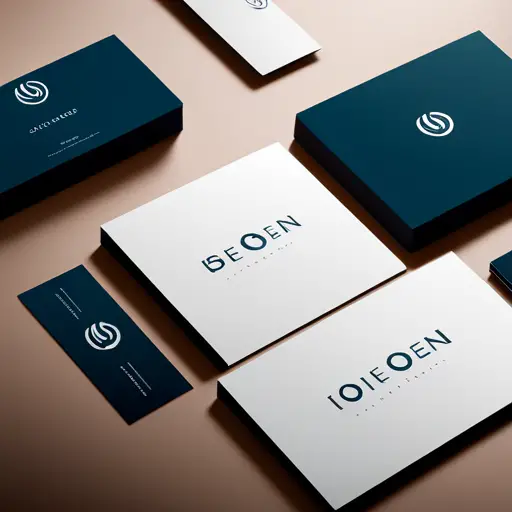Creating a Memorable Logo and Brand Identity

In the competitive world of branding, a memorable logo can be the difference between being overlooked and standing out.
Crafting a brand identity that resonates with your audience requires strategic design and a keen understanding of visual communication. From color psychology to typography, every element plays a crucial role in creating a lasting impression.
This article delves into the essential principles and strategies for creating a logo and brand identity that captivates and leaves a lasting impact.
Understanding Brand Identity
The brand identity of a company is the representation of its values, mission, and personality that sets it apart in the market. It serves as the face of the company, creating a connection with the audience. Understanding branding psychology is crucial in developing a brand identity that resonates with the target market. By utilizing colors, imagery, and messaging that evoke specific emotions and perceptions, companies can establish a strong brand recognition. This recognition is essential for creating a lasting impression and fostering customer loyalty.
Brand recognition is the extent to which the target audience can identify a brand based on its attributes. It involves not only the visual aspects of the brand, such as the logo and design elements, but also the overall brand experience and messaging. A well-crafted brand identity can influence consumer behavior and purchasing decisions, making it a powerful asset for any company.
Moving forward, it’s important to delve into the significance of a strong logo in solidifying brand identity and recognition.
Importance of a Strong Logo
A strong logo’s importance lies in its ability to serve as a visual representation of a company’s brand identity, fostering instant recognition and conveying the essence of the brand. A well-designed logo has a significant impact on customer recognition, as it becomes a symbol that is easily associated with the company’s products or services.
The following points emphasize the importance of a strong logo:
-
Memorable Brand Perception: A strong logo contributes to a positive brand perception, as it creates a lasting impression on the audience. It helps to differentiate the brand from its competitors and leaves a distinctive mark in the minds of consumers.
-
Instant Logo Association: A strong logo enables quick association with the company’s values, mission, and offerings. This association helps in building trust and credibility with the audience, as the logo becomes synonymous with the quality and reliability of the brand.
-
Consistent Brand Identity: A strong logo is a key element of maintaining a consistent brand identity across various marketing channels. It ensures that the brand’s visual representation remains cohesive and recognizable, reinforcing the brand’s message and values.
A well-crafted logo is an essential asset for any business, as it plays a crucial role in shaping the brand’s identity and influencing customer perceptions.
Elements of a Memorable Logo
When creating a memorable logo, it is essential to consider the key elements that contribute to its distinctiveness and impact. Two fundamental elements that greatly influence the effectiveness of a logo are simplicity and versatility.
| Logo Simplicity | Logo Versatility |
|---|---|
| A simple logo design is easily recognizable and memorable. It allows for quick association with the brand, making it more likely to stick in the minds of consumers. | A versatile logo can be effectively used across various mediums and applications without losing its impact. Whether it’s on a business card, website, or billboard, a versatile logo maintains its integrity and recognition. |
| A simple logo design is often timeless, ensuring that it remains relevant and effective for years to come. | Versatility allows the logo to adapt to different color schemes, sizes, and backgrounds while retaining its visual appeal and brand recognition. |
| An uncomplicated logo is more likely to be scalable without losing its visual appeal, ensuring that it looks great whether it’s on a small item like a pen or a large surface like a building facade. | A versatile logo is adaptable to different marketing materials, merchandise, and promotional items, maintaining a consistent brand image across various touchpoints. |
| Simple logos are easier to reproduce and are more cost-effective to print, embroider, or otherwise apply to different surfaces and materials. | Versatility in a logo design enables seamless integration into different brand collateral, helping to maintain a cohesive brand identity across diverse marketing channels. |
Design Principles for Logos
To effectively craft a memorable logo and solidify a brand’s identity, designers must adhere to essential design principles for logos. These principles are crucial for creating a logo that communicates the brand’s message effectively and leaves a lasting impression on the audience.
-
Logo Simplicity: A simple logo is often more memorable and versatile. It should be easily recognizable and scalable, working well across various platforms and sizes. A simple logo design also tends to be more timeless, ensuring that it remains relevant for years to come.
-
Brand Recognition: Logos should be designed to enhance brand recognition. Incorporating elements that reflect the brand’s values, mission, or industry can help create a more meaningful connection with the audience. Consistency in branding elements across all touchpoints also reinforces brand recognition.
-
Versatility: A well-designed logo should be versatile enough to work in different contexts, from digital platforms to physical merchandise. It should maintain its integrity and impact whether displayed in color or in black and white, ensuring consistent brand representation.
Color Psychology in Branding
Color psychology plays a pivotal role in branding, influencing how a brand is perceived and reinforcing the brand’s message and values through visual elements.
Different colors evoke specific emotions and associations, which can significantly impact consumer perception and behavior.
For example, red is often associated with energy, passion, and urgency, making it a popular choice for brands aiming to communicate excitement and boldness.
On the other hand, blue is often linked to trust, security, and professionalism, making it a common choice for financial institutions and tech companies.
Additionally, green is frequently connected to nature, health, and sustainability, making it a suitable option for environmentally conscious brands.
Understanding the emotional impact and color associations is crucial for brand identity development, as it allows companies to strategically leverage colors to evoke desired consumer responses and convey the intended brand personality.
Ultimately, the strategic use of color psychology in branding can enhance brand recognition, evoke specific emotions, and create a memorable visual identity that resonates with the target audience.
Typography and Branding
Typography plays a crucial role in brand identity, as different fonts convey unique emotions and messages. Font pairings are essential in creating a cohesive and visually appealing brand image, while custom typefaces can set a brand apart from its competitors.
Understanding the psychology behind fonts and making strategic choices can greatly impact a brand’s recognition and memorability.
Font Psychology in Branding
The selection of fonts in branding plays a crucial role in conveying the desired emotional and psychological impact on the target audience. The font styles used in branding significantly influence consumer perception. Different font styles evoke different emotions and associations, such as a serif font exuding tradition and sophistication, while a modern sans-serif font may convey a sense of simplicity and innovation.
Font selection is pivotal in defining brand personality. The chosen typeface should seamlessly align with the brand’s values and messaging to create a cohesive brand identity that resonates with the intended audience.
Additionally, the readability and legibility of the chosen font are essential to ensure that the brand’s message is effectively communicated to consumers.
Choosing Font Pairings
Font pairings in branding play a critical role in creating a cohesive visual identity. Ensuring that the chosen typefaces complement each other is essential to convey the intended brand personality and messaging effectively.
When selecting font combinations, it’s important to consider the visual hierarchy. Different typefaces can be used to create emphasis and hierarchy within the brand’s communication materials.
One key consideration is the choice between serif and sans serif fonts. Serif fonts often convey a sense of tradition, reliability, and sophistication. On the other hand, sans serif fonts are perceived as modern, clean, and minimalistic.
The combination of these two types can create a balanced and visually appealing brand identity. By carefully selecting and pairing fonts, brands can establish a strong typographic voice that resonates with their target audience.
Custom Typefaces for Branding
When considering custom typefaces for branding, it is important to delve into the intricacies of typographic design and its influence on brand identity and recognition. Custom typefaces play a crucial role in brand differentiation and can significantly impact brand recognition. When selecting custom typefaces for branding, consider the following:
- Reflect brand personality and values through the typeface design.
- Ensure the typeface is versatile and can be used across various brand collaterals.
- Emphasize legibility and readability to enhance brand communication.
Custom typefaces offer the opportunity to create a unique and distinctive brand identity, setting the brand apart from competitors. The right font selection can enhance brand recognition and create a lasting impression on consumers.
Moving forward, let’s explore the importance of consistency in branding.
Consistency in Branding
Consistent brand messaging across all platforms and touchpoints is essential for establishing a strong and cohesive brand identity. This requires adhering to branding guidelines to ensure visual consistency and maintaining a uniform messaging approach.
Branding guidelines serve as a roadmap for maintaining brand image and ensuring that all communications align with the brand’s essence. Whether it’s the logo, color palette, typography, or tone of voice, consistency is key in reinforcing brand recognition and loyalty among consumers.
Visual consistency across various marketing materials and digital platforms helps in creating a unified brand experience, making it easier for consumers to recognize and connect with the brand.
Maintaining brand image involves more than just visual elements; it encompasses the entire customer experience, from interactions with customer service to the content shared on social media. Uniform messaging ensures that the brand’s values, mission, and unique selling propositions remain consistent across all channels.
This consistency builds trust and credibility with the audience, ultimately leading to a more memorable and impactful brand presence.
Evolving Your Brand Identity
As businesses evolve, so should their brand identity. Visual storytelling through branding allows companies to adapt to market changes while maintaining a consistent brand evolution.
It’s important to understand how to effectively evolve your brand identity to remain relevant and resonate with your target audience.
Visual Storytelling Through Branding
One must carefully consider the visual storytelling elements when evolving a brand identity to ensure a compelling and cohesive narrative. Visual storytelling is a powerful tool for communicating a brand’s personality and values, enabling it to connect with its audience on a deeper level.
When evolving your brand identity through visual storytelling, consider the following:
- Consistency: Ensure that the visual elements used in your brand storytelling are consistent across all platforms and materials.
- Authenticity: The visuals should authentically represent your brand’s personality and values to resonate with your target audience.
- Emotional Impact: Aim to evoke emotions and create a memorable experience through your visual storytelling, leaving a lasting impression on your audience.
Adapting to Market Changes
Continuing the exploration of visual storytelling through branding, it is essential to adapt to market changes when evolving a brand identity in order to remain relevant and competitive.
Adapting to market trends and customer preferences is crucial for sustaining brand success. Market trends are constantly evolving, and customer preferences are continually shifting. Therefore, brands must stay attuned to these changes and be willing to adjust their brand identity accordingly.
This might involve refreshing the logo, updating brand colors, or even altering the brand message to better resonate with the target audience. By staying responsive to market changes, brands can ensure that their identity remains aligned with the needs and desires of their customers, ultimately fostering a stronger and more enduring brand presence in the marketplace.
Consistency in Brand Evolution
When evolving your brand identity, it is imperative to maintain consistency in order to establish a cohesive and recognizable image in the marketplace. Brand evolution should not entail a complete departure from previous visual elements and messaging. Instead, it should build upon existing brand equity while adapting to the changing market landscape.
To achieve this, consider the following:
-
Visual Continuity: Ensure that any updated visual elements, such as logos, colors, and typography, align with the existing brand identity to maintain recognition.
-
Message Cohesion: Keep the brand’s core values and messaging consistent across all communications to reinforce brand consistency and build trust with consumers.
-
Customer Recognition: Aim to retain elements that customers have come to associate with your brand to ensure a smooth transition and maintain customer loyalty.
Consistency in brand evolution is key to retaining brand equity and fostering a strong, lasting connection with your target audience.
Frequently Asked Questions
How Can I Trademark My Logo and Brand Identity?
To trademark your logo and brand identity, engage in the trademark process through the U.S. Patent and Trademark Office. This provides legal protection, preventing others from using your branding elements without permission. Consult a legal professional for guidance.
What Are Some Common Mistakes to Avoid When Designing a Logo and Brand Identity?
When designing a logo and brand identity, it’s crucial to avoid common pitfalls such as lack of simplicity, poor scalability, and inconsistency. Adhering to design principles like versatility and relevance ensures a successful outcome.
How Can I Effectively Communicate My Brand’s Story and Values Through My Logo and Brand Identity?
Effectively communicate brand’s story and values through logo and brand identity by leveraging color psychology and visual storytelling. Understand target audience to establish emotional connection and resonate with their values, ultimately creating a memorable brand identity.
What Are Some Innovative Ways to Incorporate My Logo and Brand Identity Into My Marketing and Advertising Strategies?
Innovative marketing strategies can seamlessly integrate brand identity into advertising to enhance brand recall and customer engagement. This can be achieved through creative storytelling, experiential marketing, influencer collaborations, and interactive digital experiences, fostering a cohesive brand presence.
How Can I Measure the Success of My Logo and Brand Identity in Terms of Customer Recognition and Loyalty?
Measuring the success of your logo and brand identity hinges on customer engagement and brand perception. Tracking customer recognition and loyalty through surveys, feedback, and social media analytics provides valuable insights into the effectiveness of your branding efforts.
Conclusion
In conclusion, creating a strong logo and brand identity is crucial for a business’s success.
Research shows that 59% of consumers prefer to buy products from familiar brands, making brand recognition a key factor in purchasing decisions.
By understanding brand identity, utilizing design principles, and maintaining consistency, businesses can create a memorable and impactful brand that resonates with their target audience.




